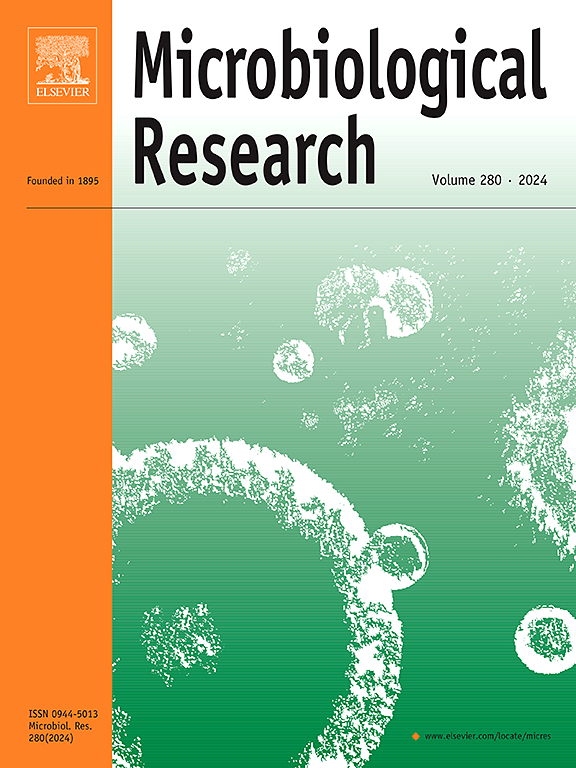植被恢复后亚热带喀斯特森林土壤氨氧化速率和N2O排放由完全氨氧化菌主导
IF 6.9
1区 生物学
Q1 MICROBIOLOGY
引用次数: 0
摘要
完全氨氧化细菌(comammox)是了解土壤N2O排放机制的关键。虽然人们已经分析了不同生态系统中comammox的丰度和组成,但很少有研究确定氨氧化速率以及comammox、氨氧化古菌(AOA)和氨氧化细菌(AOB)对亚热带喀斯特森林土壤N2O排放的相对贡献,特别是在植被恢复后。为了弥补这一空白,我们研究了喀斯特生态系统中农田(对照)和亚热带森林土壤中AOA、AOB和comammox的总丰度、群落结构、氨氧化速率及其对N2O排放的相对贡献。结果表明,与农田相比,在RNA水平上,森林中comammox总丰度显著增加(17.65 %)。此外,在农田和森林土壤中,AOA、AOB和comammox群落的优势属分别为亚硝基螺旋藻、亚硝基螺旋藻和硝化螺旋藻。植被恢复后,comammox的氨氧化速率增加了近4.4倍,这与低氨氮(NH4+-N)环境下的高氨亲和力有关。comammox对N2O排放的相对贡献在森林(40.87 %)显著高于农田(11.25 %),这与土壤质地差异有关。综上所述,植被恢复后,低NH4+-N增加了comammox氨氧化速率,因为氨亲和力高,而粗质土壤由于浆体对流流动缓慢,限制了NH4+的再分配,促进了N2O的排放。本研究强调了comammox在调节亚热带森林土壤氨氧化中的重要作用,这对改善喀斯特地区土壤氮循环和生态系统恢复具有重要意义。本文章由计算机程序翻译,如有差异,请以英文原文为准。
Complete ammonia-oxidizing bacteria dominate ammonia oxidation rates and N2O emissions after vegetation restoration in subtropical karst forest soils
Complete ammonia-oxidizing bacteria (comammox) are crucial for understanding soil N2O emission mechanisms. Although comammox abundance and composition have been analyzed in various ecosystems, few studies have determined ammonia oxidation rates and the relative contributions of comammox, ammonia-oxidizing archaea (AOA), and ammonia-oxidizing bacteria (AOB) to N2O emissions from subtropical karst forest soils, especially after vegetation restoration. To address this gap, we explored the total abundance, community structure, and ammonia oxidation rates of AOA, AOB, and comammox, as well as their relative contributions to N2O emissions, in cropland (control) and subtropical forest soils in a karst ecosystem. Our findings showed that compared with cropland, the total abundance of comammox exhibited a significant increase (17.65 %) in forest at the RNA level. Moreover, the dominant genera in AOA, AOB, and comammox communities were Nitrososphaera, Nitrosospira, and Nitrospira, respectively, in both cropland and forest soils. Additionally, the ammonia oxidation rates of comammox increased by almost 4.4 times after vegetation restoration, which attributed to the high ammonia affinity in the low ammonia nitrogen (NH4+-N) environment. The relative contribution of comammox to N2O emissions was significantly higher in forest (40.87 %) than in cropland (11.25 %), which was attributed to soil texture differences. In conclusion, after vegetation restoration, low NH4+-N increased comammox ammonia oxidation rates due to the high ammonia affinity, and coarse-textured soils stimulated more N2O emission owing to the sluggish convective flow of slurry and limiting the redistribution of NH4+. Our study highlights the important role of comammox in regulating ammonia oxidation in subtropical forest soils, which has important implications for improving soil nitrogen (N) cycling and ecosystem restoration in karst regions.
求助全文
通过发布文献求助,成功后即可免费获取论文全文。
去求助
来源期刊

Microbiological research
生物-微生物学
CiteScore
10.90
自引率
6.00%
发文量
249
审稿时长
29 days
期刊介绍:
Microbiological Research is devoted to publishing reports on prokaryotic and eukaryotic microorganisms such as yeasts, fungi, bacteria, archaea, and protozoa. Research on interactions between pathogenic microorganisms and their environment or hosts are also covered.
 求助内容:
求助内容: 应助结果提醒方式:
应助结果提醒方式:


